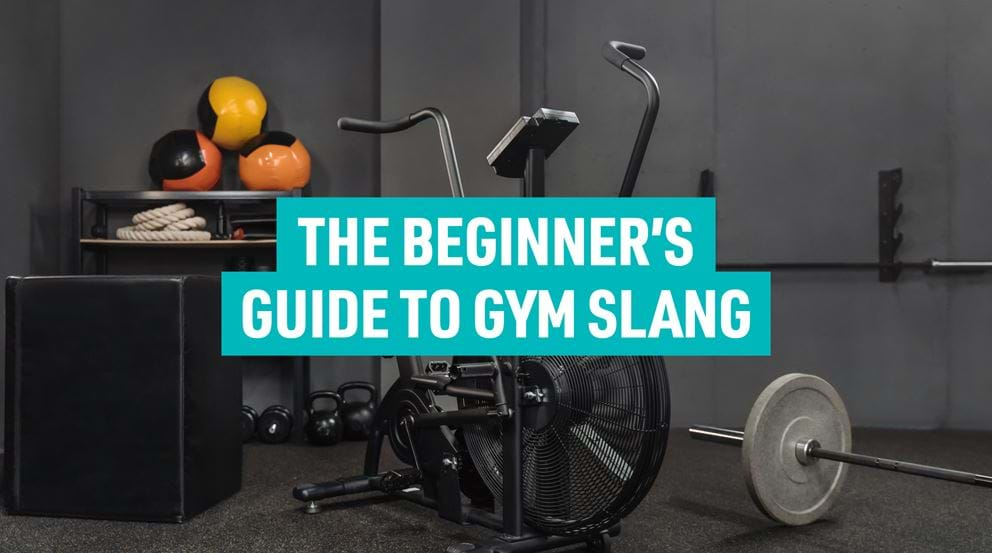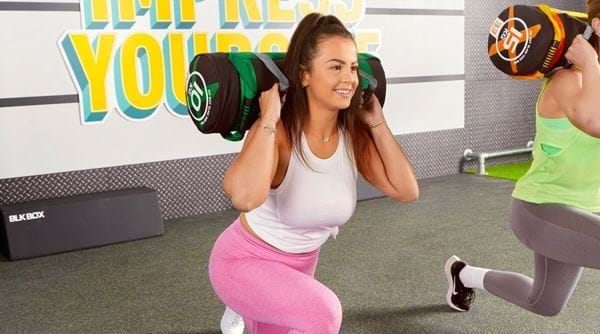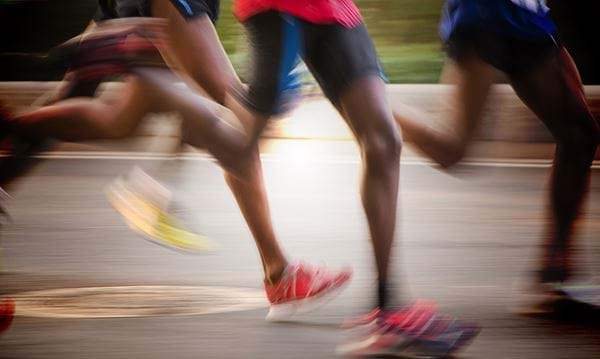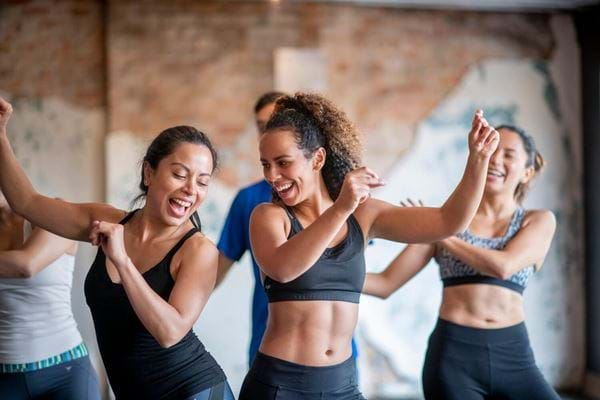The Beginner’s Guide To Gym Slang

Joining the gym can be an exciting, but nerve-wracking, journey. While there’s so many benefits to joining the gym, there’s a lot to learn – from what the best exercises for your goals are, to how long a workout should be.
There’s also a whole bunch of gym terms that are used by gym goers that can sound like a whole different language when you’re first starting out. Knowing what different gym terms mean can help to make advice both in the gym and online make a lot more sense, so here we’ve broken down some of the most common gym jargon to create a glossary of common gym terms.
We’re also sharing different gym lingo each week on our socials, as well as gym hacks, workouts, and advice, so make sure to check out our Instagram, TikTok, and YouTube too.
Common Gym Terms And What They Mean
A | B | C | D | E | F | H | I | L | M | N | O | P | Q | R | S | T
A
Active Recovery
Active recovery involves nonstrenuous activity or movement such as walking, stretching, yoga, or swimming. It is beneficial for helping you recover faster after high intensity or strenuous workouts and can be done as a cooldown following a workout, during interval training or on rest days.
Aerobic Exercise
Aerobic exercise, also known as endurance exercise, includes cardio activities such as brisk walking, cycling, or swimming. The word aerobic means “with oxygen” and refers to how the body uses oxygen to produce energy so you can continue to work at a light to moderate intensity for longer. This type of exercise has great benefit for your heart health and overall fitness.
AMRAP
This acronym stands for ‘As Many Reps As Possible’ or ‘As Many Rounds As Possible’. Often used in circuit style training, the aim is to complete as many reps or rounds in the time you have, rather than aiming for a specific number of reps and sets. With this style of training, there is an element of speed and intensity, with reduced rest time. But it’s always important to prioritise form and make sure you are still doing the exercise safely.
Anterior
Anterior means the front. You may hear the phrase 'anterior chain' in the gym, which refers to the muscles that lie on the front of the body such as your biceps and quads.
B
Barbell
A barbell is a piece of free weight equipment that is used in weight training. The barbell consists of a long metal bar which can be loaded with weight plates. The standard Olympic barbell is 20kg, and there is a slightly shorter barbell which weighs in at 15kg. There are also preloaded barbells which come in range of weights but can't have any plates added to it to change the weight.
Bench
A bench is a piece of equipment typically used for weight training to provide support to the performer. Benches can be of various designs such as fixed horizontal for exercises likes Flat Bench Press, fixed incline for exercises like Incline Bench Press and adjustable benches which are often found in the free weights area of a gym. You may also hear some people in the gym refer to the bench press, a chest exercise, as bench
BCAAS
BCAAs, short for Branched-Chain Amino Acids, are like the superhero trio of amino acids – leucine, isoleucine, and valine. Your body can't make them, so you've got to get them from your food or supplements. BCAAs are very important when it comes to fitness as they help to build and repair muscles, give you energy when you're working out, and make those post-workout aches less painful. Athletes and active people often take BCAA supplements to boost their muscle growth, speed up recovery, and feel better during their workouts.
Bike Speed
Bike speed is a phrase you may hear during a cycle class at the gym and it simply relates to the speed in which your legs are pedalling at - otherwise called revolutions.
Bis
Bis is a slang word for biceps, which are the muscles at the front (anterior) of your upper arms. You can target your biceps with exercises such as barbell bicep curls and preacher curls.
BMI
BMI stands for Body Mass Index, and is a measure calculated by your height and weight. This figure can provide an estimate of if someone is at a healthy weight, however it is not always accurate as it doesn't take into account your muscle and fat mass distribution, so shouldn’t be taken as the sole measure of health.
Body recomposition
Body recomposition, or recomp, is an approach to fat loss that involves eating at maintenance or a very slight calorie deficit while lifting heavy. The idea is that this will allow the person to build muscle while losing fat, although weight will likely stay the same.
C
Calisthenics
Calisthenics is a style of strength training that uses bodyweight and gravity to provide resistance, rather than weights. Only minimal equipment like paralettes and pull up bars are used, and more advanced calisthenics exercises require a high degree of strength, mobility, and flexibility.
Cardio
Cardio or aerobic exercise is any exercise which raises your heart rate and speeds up your breathing. Cardio improves your heart and circulatory health, burns calories, and releases feel good hormones.
Clips / Collars
Clips, sometimes called collars are handy pieces of kit that fix onto the end of the barbell to keep the weight plates securely in place throughout an exercise.
Cool Down
A cool down is the last part of your workout that helps to bring your body back to a pre-workout / normal state. It might involve some gentle movement such as slowly walking on a treadmill to help bring your heart rate back down and then some static stretches for the relevant muscles you’ve trained to help avoid stiffness and tightness.
Compound exercises
Compound exercises are movements which work multiple joints and muscle groups in one exercise, such as squats or deadlifts. Compound exercises help you to build strength and size, elevate your heart rate and burn calories more efficiently as you’re targeting more muscles in a shorter space of time. These are excellent exercises that should make up a large part of any strength training programme, and then complimented with isolation exercises.
Concentric
The concentric portion of an exercise refers to the part when you contract (shorten) the muscle, also known as the lifting phase. This stage of an exercise involves the load (either you or the weight) working against the force of gravity, such as the upward phase of a bicep curl or when you drive up out of the lowest portion of a squat.
Cutting and bulking
Cutting and bulking are two sides of a cycle used to lose (cutting) or gain (bulking) weight, with the intention of improving body composition. When someone is bulking, they eat additional calories while lifting heavy to maximise hypertrophy or strength. This is usually followed by a cutting phase, where they eat at a calorie deficit to lose fat gained during the bulk while preventing as much muscle loss as possible.
D
Drop Set
Drop sets involve completing an exercise within your desired rep range, using a weight that takes you to failure, before then immediately dropping to a lighter weight and completing more reps. Drop sets can are a great way to increase intensity and volume in your workout and can help to maximise muscle hypertrophy.
DOMS
DOMS stands for ‘delayed onset of muscle soreness’ and refers to the feeling of soreness or muscle ache that you may experience one to two days after training. They’re caused by tiny micro tears within the muscle, which occur particularly during resistance training and the eccentric (lengthening) phase of the movement.
DOMS are a very common thing, and not something to be worried about – but they can be very inconvenient for your training. You may find it helpful to train a different muscle group or take an extra rest day to help you recovery.
Dynamic stretches
Dynamic stretches are active movements that work the joints and muscle through a full range of motion. They are often used to warm up before a workout and can help to improve mobility and flexibility.
E
Eccentric
The eccentric phase of an exercise refers to the lengthening portion and occurs when the movement works with the force of gravity. This phase is sometimes referred to as the 'lowering phase' and is the opposite to the concentric (lifting) phase. An example of an eccentric portion of an exercise is the lowering of the dumbbell during a bicep curl or sitting into a squat position.
EMOM
EMOM stands for 'Every Minute On The Minute' is a form of interval training which involves completing a pre-determined number of reps of a particular exercise or exercise(s) within 60 seconds. You then use whatever time is left to rest and recover before moving onto the next set when the next minute starts.
EZ Bar
The EZ bar is a smaller bar with a W shape, which offers multiple angles for it can be held at. This bar is typically used for bicep and tricep exercises and can be more comfortable because it places less stress on the wrist and elbow joints than a straight bar. You can get both pre-loaded EZ bars and ones that you can load your own weight plates on to.
F
Free Weights
Free weights are weights which aren’t attached to a machine or the ground so can be picked up and moved around, like dumbbells or barbells. You may also hear the term 'free weights area' in the gym, and this just refers to the area where you will find a wide range of dumbbells and adjustable benches.
Functional fitness
Functional fitness involves training in a way that improves full body strength and mobility by using real life movements, like pushing, lifting, climbing, twisting, and pulling. This style of training helps to perform daily activities, as well as sports, more easily.
H
Hammys
Hammys is a slang word for hamstrings, which are the group of muscles in the back of your upper leg / thigh.
HIIT
Short for high intensity interval training, HIIT is a style of workout that pairs short bursts of movement at high intensity with short periods of rest or lower intensity movement. It's a great workout option if you're short for time!
Hypertrophy
Hypertrophy is a technical term that relates to an increase in muscle growth and size. Training with muscular hypertrophy in mind means the exercises, reps, and sets you perform will be focused on increasing mass, rather than building strength (although both will happen). If your goal is hypertrophy, it's recommended to stick within a rep range of 6 to 12 reps.
I
Isolation exercises
Isolation exercises are the opposite of compound exercises and work a single muscle and joint instead of large muscle groups - for example, bicep curls. Isolation exercises are a great way to pay particular attention to specific muscles that will help you reach your goals, work on reducing muscular imbalances and rehab sports injuries.
Isometric Hold
Isometric exercises involve holding a position where the muscles are contracted, for example a wall sit or a plank. Isometric holds help to build strength and endurance while putting minimal stress on the joints. They can also help to build mind muscle connection.
L
Lats
The lats are a phrase commonly used to describe your latissimus dorsi, which are a large, fan or 'V' shaped muscle on either side of the back. It starts under the shoulder, extends down the back, and wraps around the side and under the arm. It’s the widest muscle in the body and a key driver in pulling exercises such as pull ups and lat pull downs.
LISS
Low intensity steady state cardio, or LISS, is a type of training that involves performing low intensity cardio such as walking, for a longer period of time.
M
Macros
Macros is short for macronutrients, which refers to the three categories of nutrients in food: protein, carbohydrates and fat. Some people track their 'macros' and this just refers to having an understanding of the distribution of carbs, protein and fat within your daily food intake, to help enhance performance. For example, tracking your protein intake to help with muscle gains.
Mind-Muscle Connection
The mind-muscle (or mind-body) connection refers to the practice of thinking about the muscle you’re targeting while doing the exercise. This connection is thought to help you better engage and recruit the right muscles, boosting the benefits you see from the exercise.
N
NEAT
NEAT means non-exercise activity thermogenesis, and refers to the calories burned in anything you do outside of sleeping, eating, or exercising.
Negatives
Negatives involve slowing down the eccentric portion (lengthening / lowering phase) of the exercise to increase the time under tension. This technique is useful for building strength, particularly in bodyweight exercises like push ups and pull ups when you are unable to complete a full rep.
O
One Rep Max (1RM)
1RM stands for ‘One Rep Max’ and is the maximum weight you can lift for one repetition. Occasionally testing your 1RM can be a good way to track your strength progress, but not a necessary part of your training. If you do want to test your 1RM, especially if you are new to the gym, always remember to use safety bars and have a trusted spotter with you.
P
PB/PR
This stands for Personal Best or Personal Record. It’s often used to describe the heaviest weight you have lifted or the fastest time that you have completed (running, cycling, rowing etc.) over a set distance.
Pecs
Pecs are short for pectorals, which is the name for the muscles in your chest. Exercises such as chest press, press ups and pec dec work your chest muscles.
Plateau
If you’re noticing that your progress is slowing down or stalling altogether, despite you staying consistent in the gym and with your nutrition, you may be experiencing a plateau. It’s a common thing to happen, and not something to worry about.
The most common cause of a plateau is that your body adapts to the stimulus (your workouts) and no longer finds them to be challenging. As you get fitter and stronger, you therefore need to try to increase your intensity, speed, or weight to avoid hitting a plateau – this is called progressive overload.
But you may also be experiencing a plateau because of external factors like stress or lack of sleep. In these cases, it can sometimes be helpful to take a break or decrease the intensity of your workouts (de-load) for a short period of time.
Plates
Plates are flat weights that can be loaded onto a barbell to increase the load. They come in various sizes and weights, usually starting from 1.25kg up to 25kg. You may also hear the phrase 'bumper plates' in the gym - these are large rubber plates, which are wider than typical weight plates. You'll typically find bumper plates in lifting platforms for use during exercises such as deadlifts.
Plyometrics
Plyometric training is a style of workout that focuses on using powerful and explosive movements to build speed, strength, and power. Plyometric exercises by definition involve stretching a muscle, followed quickly by a shortening movement.
Posterior
Posterior means the back. You may hear the phrase 'posterior chain' in the gym, which refers to all the muscles on the back of the body such as your hamstrings, glutes and lower back.
Progressive overload
Progressive overload is a training principle which helps to stop your progress in the gym from plateauing. If you do the same workouts over and over again, using the same amount of weight, work which was once challenging will become easy and you’ll stop making progress.
Progressive overload involves gradually changing your workout or stimulus to keep your body and muscles challenged. The easiest ways to implement progressive overload are by increasing the weight, the number or repetitions or reducing the rest time. Once you’re more familiar with the gym, you can also try things like increasing your time under tension or increasing the total length of your workout.
Q
Quads
The quads, short for quadriceps, are the group of muscles that make up the front of your leg / thigh.
R
Range Of Motion
Range of movement, also known as ROM, is how far you can move or stretch a part of the body. It’s a very personal thing, and dependent on your flexibility and mobility. In the gym you may hear the phrase “full range of movement” which is in reference to trying to perform an exercise at its full intended range, for example a squat at full depth. Using a full range of motion recruits and strengthens more muscle, helps with mobility, and can lead to better gains.
Reps
Short for repetitions, a rep is used to describe one full movement of a certain exercise. 8 reps would mean performing an exercise 8 times.
Resistance Machines
Resistance machines are workout machines which provide resistance to a movement in order to challenge the muscles. These machines follow a fixed movement path and are ideal for beginners, as well as anyone who wants to isolate a specific muscle. Examples of resistance machines include the leg press, lat pulldown, and shoulder press machine.
RPE
RPE stands for ‘rate of perceived exertion’ and is a way to measure the intensity of an exercise. There are many different RPE scales, but the simplest way is to use a scale of 0 – 10, with 0 being the lowest and 10 being maximal effort.
RPM
RPM stands for revolutions per minute and refers to the number of times the pedal on a bike rotates within 60 seconds. It’s essentially a way to track the speed at which your legs are pedalling and most indoor bikes have a display which shows you your RPM.
S
Set
A set refers to a group of consecutive repetitions and is followed by a rest. For example, if you did 8 repetitions that is classed as 1 set. You may also see this displayed on workout programmes as 12 reps x 3 sets.
Static stretches
Static stretches involve positioning a muscle at its end range and holding this position for a period of time, usually around 30-60 seconds. These are usually performed at the end of a workout and can help to improve flexibility and prevent DOMs.
Superset
A superset involves performing reps of one exercise, followed immediately by reps of a different exercise, with no rest in between. They can either be used to increase the intensity and volume of work on a particular muscle, for example, lateral raises superset with front raises. Or, can be used to target muscular pairs (agonist and antagonist) such as biceps curls superset with triceps extensions. This allows more work to be done with the same amount of rest.
T
TDEE
TDEE, total daily energy expenditure, is the total number of calories burned by a person in a full day, encompassing everything from exercise, to fidgeting, to breathing.
Toning
Toning is a common phrase you may hear in the gym, which often refers to sculpting and defining lean muscle without putting on bulk or size. It involves resistance training, but the goal is often to decrease body fat and gain lean muscle rather than solely build strength and size.
Training To Failure
This involves using a weight that is heavy enough that you are unable to complete another rep after you reach your desired rep range. Training to failure can help to create strength and muscle mass gains more effectively.
Tris
Tris are slang for triceps, which are the muscles on the back (posterior) of your upper arm. You can target your triceps with exercises such as tricep presses and tricep dips.
TUT
TUT stands for ‘time under tension’ and is the amount of time a muscle is held under tension during an exercise. By slowing down the tempo of your exercises you can increase the muscles time under tension, which can help to build strength, size, and muscular endurance.
You can either do this by increasing the time spent in every phase of the movement, or by concentrating on slowing down the tempo of the eccentric phase.
U
Unilateral
A unilateral exercise is when an exercise is performed on just one side of the body at a time, for example, a lunge or a single arm shoulder press. It’s very common to have one side naturally stronger than the other, so including unilateral exercises into your workouts is a great way to improve any muscular imbalances between the two sides.
Now you’re all brushed up on gym terms and what they mean, you are ready to go! Make sure to check out our guides to getting started at the gym here for more advice including beginner-friendly workouts, what to wear to the gym, and more. Not a member yet? Find your nearest gym here.


